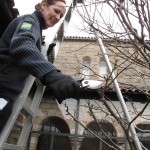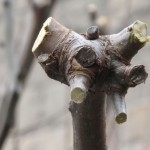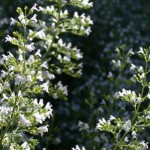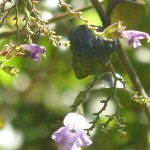Posts Tagged ‘Cuxa Garden’
Friday, June 15, 2012
The Cloisters offered its annual Garden Days program on June 2 and 3. We had splendid weather and a great turnout. Deirdre Larkin, familiar to all of our regular readers, led garden tours in which she explored the theme of wild and cultivated plants in the Middle Ages. Instructors from our Education Office led workshops for children and their families.

Deirdre Larkin, at center, discussed wild and cultivated plants in the Bonnefont herb garden. Some of the plants in the garden are considered weeds today but were highly valued in the medieval world. Most of the beds in Bonnefont are planted according to use; nearly every bed was completely replanted this spring. Photograph by Nancy Wu
Read more »
Tags: Bonnefont Garden, Cuxa Garden, Garden Day, weed
Posted in Gardening at The Cloisters | Comments (2)
Friday, February 25, 2011
A medieval technique of hard pruning, known as pollarding, is used on the four crab apple trees in Cuxa Cloister garden to control the height of the trees and the spread of their canopies. The pruning is done in late winter, while the trees are still dormant.
Above:??Frances Reidy, our arborist, cutting last spring’s growth back to the same “head” as the previous spring’s. This successive hard pruning produces the “knuckles” of tissue characteristic of pollarded trees. This is the third year in which the technique has been applied; the knuckles at the head of the branches will become more pronounced as the pollard matures.
Read more »
Tags: ash, crab apple, Cuxa Garden, pollarding, willow
Posted in Gardening at The Cloisters, Medieval Agriculture | Comments (6)
Thursday, February 10, 2011
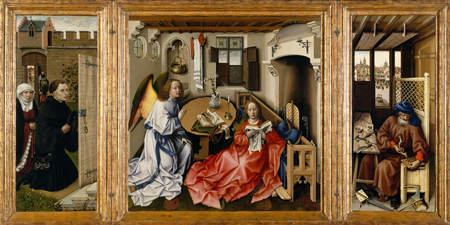
Robert Campin and Workshop (South Netherlandish, Tournai, ca. 1375???1444). Triptych with the Annunciation, known as the “Merode Altarpiece,” ca. 1427???32. Made in Tournai, South Netherlands. Oil on oak. The Metropolitan Museum of Art, New York, The Cloisters Collection, 1956 (56.70a???c). See Google Art Project for an in-depth look at this work.
A great many things have changed during the twenty years that I’ve been working at The Cloisters, but its special atmosphere remains constant. One of the most unique aspects of the Museum is the way in which the gardens are integrated into the collection. From the Museum’s inception, the curators envisioned the artwork and gardens as a whole, where the plants were not merely aesthetic elements, but also of great educational value. Many of the galleries either open directly onto or provide views into one of the three interior gardens (see floor plan). This arrangement encourages visitors to experience the gardens as part of medieval culture, to make connections between the plants and the objects, and to understand both within the historical context presented in the galleries. Read more »
Tags: Antonites, Bellis perennis, Claviceps purpurea, corn poppy, Cuxa Garden, English daisy, ergotism, fungus, Galen, grain, hermit, ignis sacer, Isenheim, mandrake, Matthias Gr??newald, monasticism, Niclaus of Haguenau, plantain, poppy, sage, Saint Anthony Abbott, Saint Anthony's Fire, Saint Vinage, Tau cross, verbena
Posted in Gardening at The Cloisters, Plants in Medieval Art | Comments (1)
Wednesday, November 17, 2010
The pretty, fragrant lesser calamint flourishes in all three of the enclosed gardens at The Cloisters. Each small shrub bears a host of delicate little flowers from late summer through frost. Above, from left to right: The lipped flowers of calamint are characteristic of members of the Labiatae, or mint, family; cold weather brings out the purplish cast in the flowers; calamint is beautiful even in winter, when the fine stems are bare.
The larger-flowered calamint, known as Calamintha grandiflora, is frequently grown in modern gardens, but the lesser calamint, Calamintha nepeta, is the calamint of the Middle Ages. Read more »
Tags: calamint, Calamintha grandiflora, Calamintha nepeta, Calamintha officinalis, Cuxa Garden, marjoram, nepitella, Satureja hortensis, Satureja montana, savory, White Cloud
Posted in Food and Beverage Plants, Gardening at The Cloisters, Medicinal Plants | Comments (1)
Tuesday, July 8, 2008
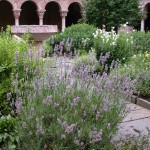
Above: Lavandin (Lavandula x intermedia) flowering in Cuxa Garden.
Lavenders in The Middle Ages
Lavender (Lavandula angustifolia ssp. angustifolia) was used to scent linen and to keep moths and insects from woolens, as it still is. According to the fifteenth-century herbal Hortus Sanitatis, or the Garden of Health, this virtue of protecting clothing from vermin endeared lavender to the Mother of God, who also loved the herb as a preserver of chastity: “If the head is sprinkled with lavender water it will make that person chaste so long as he bears it upon him.” (Margaret Freeman, Herbs for the Medieval Household, 1943.)
Lavender had a number of medicinal applications as well as household uses, and could be employed against pains in the heart, fainting spells, and sleeplessness; it was applied to the forehead for headache and included in antidotes, such as a plaster for scorpion bites. It was used internally as well as externally, and a decoction was drunk for epilepsy and kidney ailments and as a preventative for apoplexy. (Frank Anderson, German Book Illustration through 1500: Herbals through 1500, 1983???4.) Read more »
Tags: Add new tag, Bonnefont Garden, Cuxa Garden, lavandin, Lavandula, lavenders
Posted in Fragrant Plants, Gardening at The Cloisters, Medicinal Plants | Comments (4)
Tuesday, July 1, 2008
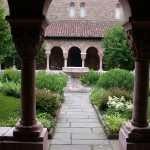
Welcome to The Medieval Garden Enclosed, a blog dedicated to the plants and gardens of The Cloisters, a branch of The Metropolitan Museum of Art. Enter and explore the role of plants and gardens in medieval life and art, learn how to find and grow medieval herbs and flowers, discuss the long histories of many familiar garden plants, discover which roadside weeds were once valued medicinals, and encounter legendary plants like the mandrake (Mandragora officinarum.) Read more »
Tags: Bonnefont Garden, Cuxa Garden, garth, hortus conclusus, Trie Garden
Posted in Introduction | Comments (54)


